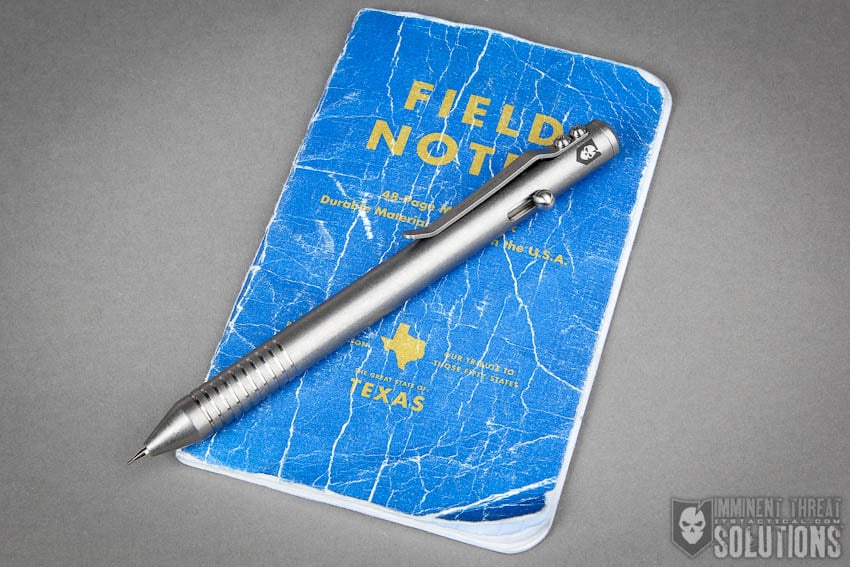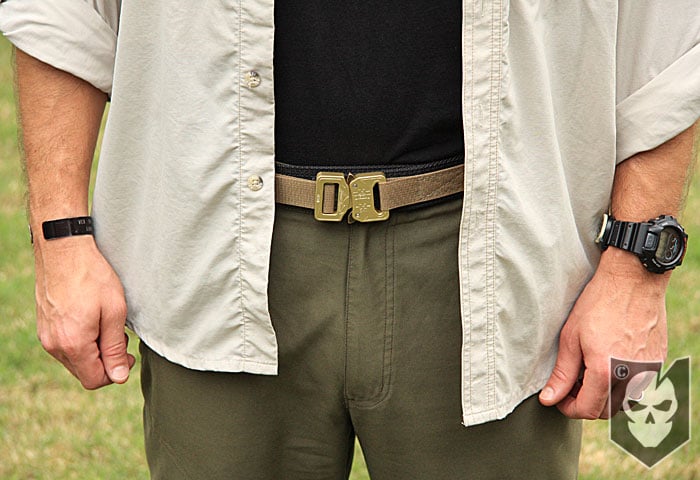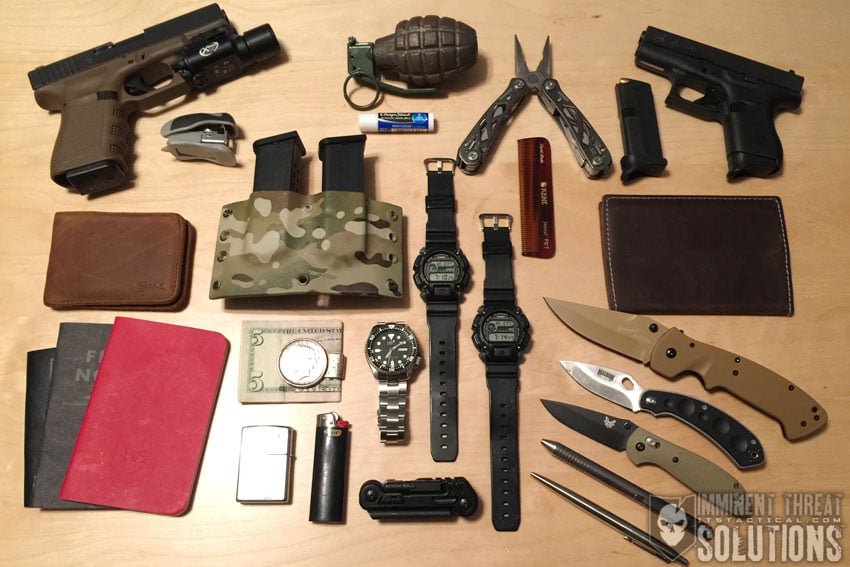Every Day Carry Planning – Step One: Security Threat Assessment
Every Day Carry Planning – Step One: Security Threat Assessment
- Every Day Carry: Careful and Reasonable Planning is the Key to Success
- Every Day Carry Planning – Step One: Security Threat Assessment
- Every Day Carry Planning – Step Two: Plan Reasonable Responses to Perceived Threats
- Every Day Carry Planning – Step Three: Identifying Tools, Resources and Supplies
- Every Day Carry Planning – Step Four: Assembling Your Kits
This is the second in a five part Every Day Carry series to help show how careful and reasonable planning will promote better selection of tools, resources and supplies for EDC kits. The first article in this series presented an overview of the analytical process for deciding on the composition of our kits. In a nutshell, the process involves the following four steps:
- Security Threat Assessment
- Articulate Reasonable Threat Responses
- Identify Necessary Tools, Resources and Supplies
- Allocate Items Among EDC kits kept at Home, Work, in your Vehicle(s) and on your Person
This article addresses the first step in the process, conducting a security threat assessment to identify the scope of events we’d like to be better prepared for with our every day carry kits.
Since this is a structured thought process, we need to look at it one piece at a time for better understanding and to see how one portion of the analysis relates to others. If done correctly, we’ll have a complement of items that are essential for our EDC kits. In addition, the same process conducted in reverse will allow us to validate the content of kits we’ve already assembled.
Ground Rules
Here are four ground rules to keep us on track with this first step of the process.
First, acts of war aren’t appropriate to address since our focus is EDC for civilians. As such, our objectives are safety, security and survival, not retaking the state or country from another military force.
Second, postulating events will allow us to identify likely consequences, and it’s only the serious consequences for which we need to be prepared. Consequences are more important than the events that create them, so there is no need to exhaustively address all possible events when their consequences are known to be the same. For example, it doesn’t matter if a flash flood or tornado takes out a main traffic artery, what matters most is the roads are closed and all personal and commercial traffic stops. Also, consequences that are less than what might threaten our safety, security and survival can be ignored. For example, although theft might cost us money and torque us off, it usually doesn’t affect our safety, security or survival.
Third, we need to take credit for effective preventive measures so we’re only preparing for things that aren’t generally within our control or are otherwise unavoidable. For example, we need to assume that keeping a full tank of gas (our preventive measure) eliminates the possibility of running out of gas (a security threat during vehicle travel), so we wouldn’t consider running out of gas to be a security threat in our assessment.
Fourth, our analysis must remain reasonable if we want it to be meaningful. For me, reasonable suggests events that are likely to happen in my lifetime based on historical evidence or other information about my lifestyle that a reasonable person might see as suggesting a vulnerability to a particular threat. In other words, we have reason to believe that one event or another is a threat to our safety, security or survival.
Vertical Slices as Examples
To keep this as realistic as possible, I’m going to use myself as an example. In the interest of staying more focused, instead of looking at a very broad spectrum of events, I’ll examine a few “vertical slices” that represent a limited number of threats that I might face. Using this approach will allow us to narrow the focus so we can afford to go into depth (here and in subsequent steps) that will show the entire analytical technique.
If you decide to pattern your own analysis after my examples, you’ll want to address a full spectrum of threats.
Security Threat Assessment
I live outside of Cheyenne, Wyoming where we face several types of threats, but not nearly the full range that one might face in a large metropolitan area. I generally work from home and around the house, but venture into town at least once every week or two, sometimes more frequently when errands, business or social activities warrant. I also travel across the country by personal vehicle.
With that as a background, I’ll examine three general threats in detail:
- crime
- severe weather
- vehicle breakdown
For each of these areas, I’ll define the security threats and their consequences, assumptions I make, and preventive measures I’m taking credit for, if any. Then, I’ll summarize the threats that I determine to be serious and worth being prepared for. These threats will then be addressed in step two of the analysis – threat response planning.
Crime
The general area of Cheyenne isn’t known as a hotbed of crime. We get a taste of everything that criminals have to offer, but it’s toned down very much from what one might expect in a large city. Nevertheless, we could experience just about any type of crime based on what I’ve read, heard about, and what I can reasonably expect from a growing town that includes a broad spectrum of people. Therefore, my assessment recognizes the security threats of: armed robbery; simple assault; armed assault; and, strong armed robbery.
The consequences of these threats include bodily injury and death, so they need to be addressed in my every day carry planning. Without a doubt, the consequences of these criminal acts are a threat to my security, safety and survival.
My assumptions are that armaments will likely be clubs, knives and hand-held firearms – all of which lend themselves to being easily concealed. Since it’s common for assailants to work in pairs, I also assume that I will likely face two to three adversaries instead of just one. Abduction isn’t considered to be a reasonable threat to me because I’m not a high profile individual that might attract interest of others who desire to extract money or valuables, or hold me for ransom. I’ll also assume that car jacking isn’t a reasonable threat as I don’t drive a new, flashy or otherwise desirable car or truck. I’m also eliminating theft as a security threat simply because it doesn’t place my security, safety or survival as risk.
My preventive measure that is effective against violent crime is traveling in numbers, but most of my time is spent alone, so this preventive measure has limited value as it is short-lived and infrequent – not something that I can count on to deter violent criminals.
Severe Weather
Severe weather is common in my neck of the woods, just about any time of year. It’s something that I’ve experienced, seen reported, heard others talk about, and read in historical records. So, my assessment recognizes the security threats of: hurricane force winds; flash floods; tornadoes; life threatening hail; ice storms; blinding blizzards; fog that closes roads; ground blizzards; impassible snow drifts; and, below zero temperatures.
The consequences of severe weather include being stranded in-place ( be that in town, on the road or at home). It is also reasonable to foresee a threat to my health and life from flying and falling debris, drowning and exposure to extreme cold. I should also expect a possible interruption in the normal supply of food, merchandise, fuel, electricity, natural gas, and water. Tornadoes could easily destroy my home and vehicle. Hail could damage the vehicle windshield to the point where only slow speed travel would be possible. Blowing and drifting snow could strand me on the road.
My assumptions are that any interruption of travel won’t last for more than three days. Hail is usually a threat that passes within minutes, and high winds usually don’t last more than half a day. Local interruptions of electricity could last a week, whereas regional interruptions could last as much as a two months. My residence is in an area of low population density, so we would be a last priority for restorative services.
The preventive measures that are effective with respect to severe weather include choosing the time to travel, remaining inside a building or vehicle for cover, never letting my fuel tank drop below one quarter full, turning off my vehicle if I need to wait in traffic for more than a few minutes, and keeping refrigeration appliances closed in the absence of electricity.
Vehicle Breakdown
There are many and varied types of vehicle breakdowns that could occur. To eliminate naming all types, let’s focus on two basic failures: operator serviceable in the field; and, failures that require a repair shop or diagnostic capabilities. Operator serviceable failures addressable in the field encompass: flat tire, loose lug nuts, leaking cooling system, failed battery, loose electrical connection, blown fuse, low fluid levels, failed bulbs, deteriorated wipers, and loose body panels or cowling. All other failures will likely require assistance in the form of towing and/or shop services. Any failure that requires stopping the vehicle (or stops the vehicle) is deemed a security threat because when and where I’ll have to stop the vehicle is largely unknown and outside of my control.
The consequences of vehicle breakdown include delay of travel, perhaps for days, risk of being hit while conducting field repairs alongside of the road, exposure to the elements while diagnosing and making repairs, exposure to criminals on the road and while stranded in high crime areas, inability to travel at night in the event that headlights become inoperable, inability to stay ahead of or get out of severe weather conditions, and exposure to temperature extremes in the event that the heater or air conditioning becomes inoperable.
My assumptions are that most incipient failures will be noticed and addressed before they become catastrophic failures. This includes shutting down the vehicle to prevent an undesirable situation from worsening to the point of failure. I also assume rudimentary knowledge of vehicle systems and how they work, what indicators and warning lights suggest with respect to failure, and the physical capability to perform limited strenuous activities like breaking loose lug nuts and jacking up the vehicle. Lastly, vehicle failures will exhibit themselves randomly, and could occur at any time, any location, and during any weather condition.
Effective preventive measures with respect to vehicle failure include routine servicing and inspections to detect conditions that need to be addressed so consumable components of the vehicle are maintained in serviceable condition, or replaced, and are not allowed to become marginal with respect to remaining life expectancy OR performance. Preventive measures also include keeping a spare tire properly inflated and avoidance of tire hazards while driving.
Summary of Threat Consequences
If we look at the security threat assessments for each of the vertical slices, there are a number of serious consequences that I should be guarding against. In summary, they are:
- Bodily injury from one or more adversaries armed with hand-held weapons such as knives, clubs and firearms.
- Stranded in town or on the road (local travel only), or at home for up to three days.
- Bodily injury from flying and falling debris.
- Deep and swift moving water in places where it’s unexpected.
- Extreme cold or heat in my inoperable vehicle.
- Extreme cold at home without an electric supply.
- Interruption in the normal supply of food, merchandise and fuel for three days.
- Interruption in natural gas and water for one week, and possibly up to two months.
- Destruction of my home to the point where it no longer provides adequate shelter.
- Destruction of my vehicle while on the road.
- Damage to my windshield such that only slow speed travel is possible.
- Delay of vehicle travel for days while on the road.
- Exposure to harsh outdoor weather while restoring my vehicle to service.
- Failed headlights while on the road.
- Failed heater and defroster while on the road in cold weather.
- Temperature extremes inside the passenger compartment of my vehicle (while moving or stranded).
- Vehicle stuck in drifting snow.
I know this looks like an intimidating list, but that’s what happens when you carefully consider all reasonable threats that you might possibly face in your lifetime. I promise it will get whittled down a bit and start to make more sense as I explain the next several steps in the needs analysis for every day carry kits.
The Next Step
In the next article in this series, I’ll organize each of the security threats above in terms of location, and then I’ll prioritize them in terms of likelihood of occurrence. This will help us better plan our responses which will lead us to determine what we might want to have available in our every day carry kits.
Thank you for making it this far. I hope you’ll stay tuned for the next three articles in this series as we’ll take the results of the analyses of these “vertical slices” and look at: reasonable planned responses; the need for tools, resources and supplies; and, then determine how to allocate the items for our every day carry kits that we might keep at home, on our person, in our vehicles, and at our place of employment.
Editors Note: Be sure to check out our ITS Tactical EDC Flickr Group to share and check out what all our readers are carrying every day.
About the author: Clair Schwan is a managing editor at the http://www.Self-Reliance-Works.com where being prepared, counting on yourself, and living a self directed life are core values of the team of contributing authors. He also hosts www.Frugal-Living-Freedom.com where he advocates wise use of financial resources, do-it-yourself projects, growing your own food, and raising small animals for meat and eggs. He advocates being sufficiently prepared to thrive in any given situation, not merely survive.











Discussion